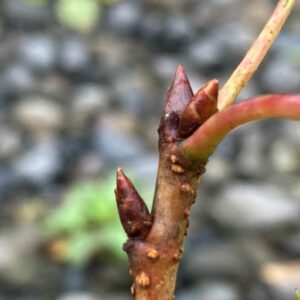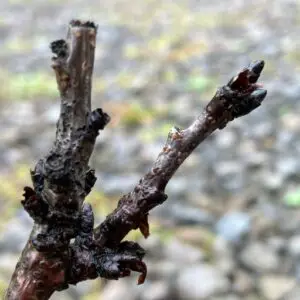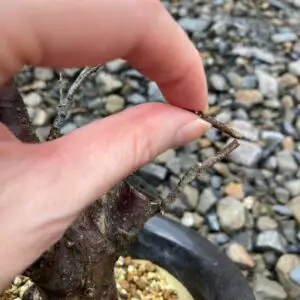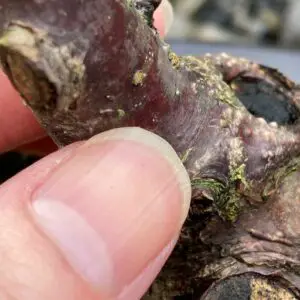It is sometimes hard to tell if a bonsai tree is dead or dormant.
If branches bounce back when bent and inner trunk is green/sappy when scraped, your bonsai tree is alive. If branches break and inner trunk is brown/dry, it is probably dead.
Let’s see in detail how we can tell.
Is your bonsai dead or dormant? : Deciduous species
Deciduous trees are those that shed leaves in fall. Examples of bonsai species include-
- maple,
- elm,
- cherry blossom,
- oak, and
- zelkova.
How deciduous bonsai trees go dormant
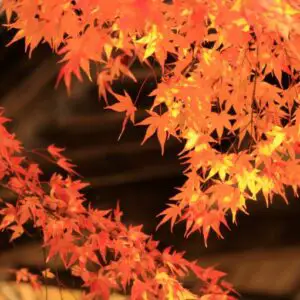
Japanese maple in orange
Winter dormancy is a protection measure for trees to survive freezing temperatures and harsh wintertime environments. As the word “winter” dormancy shows, deciduous bonsai trees do not go dormant naturally in spring, summer and early fall when it is still warm.
Deciduous bonsai trees go dormant when they are triggered by several factors including-
- shorter daytime,
- lower temperature, and
- reduced light intensity.
Typically for deciduous bonsai trees, leaves change color and fall, shoots are covered into buds, and they stop growing altogether just before they go dormant.
Roots, on the other hand, do not usually go dormant because they live in a more protected environment underground, although the trees seem resting above ground. This is why bonsai pots need winter protection to prevent the soil from freezing.
Dead or dormant deciduous bonsai? How to tell
Visible test
It is usually hard to tell if your deciduous bonsai trees are dead or dormant in winter because they shed all leaves in fall and look somewhat similar to dead trees. But there are, of course, differences that we can visibly check.
Here are some of the differences between dormant and dead deciduous bonsai trees.
| Dormant | Dead | |
| Buds | Multiple buds, shiny and alive∗ | -No buds -Buds that are dry and shriveled in all the branches |
| Bark | Smooth, firm bark without unusual cracks and holes | -Missing bark -Bark peeling away -Multiple cracks on the bark inside of which looks dry -Infestation with insects/fungi |
| Root | White | Dark brown or black |
∗Color may vary from dark brown/red to green
I believe the best course of action when you are not sure if your bonsai tree is dead or dormant is to check your tree visibly and still wait until spring comes, watering every 3-4 days in the meantime. Even if your tree looks completely dead, there is always a chance that it may come back to life.
Bending and scratch test
There are two tests you can do to check if your bonsai trees are dormant or dead: bending and scratch test.
- Bending test: Bend some of the branches at around 90 degrees.
- Scratch test: Scratch the bark on the branches with your thumbnail. You can also scrape the bark of the main stem just below the soil line or on the roots themselves.
Keep in mind that scratch tests on deciduous bonsai trees are invasive and that the risk of tree bark never healing is high for soft bark bonsai trees like a Japanese maple.
The table below shows how dormant and dead trees look under the test.
| Dormant | Dead | |
| Bending | Bounce back | Snap and break |
| Scratch (branch) | (White) green, sappy | Brown/gray/white, dry |
| Scratch (roots) | White | Brown/black |
Bending and scratch test on flowering plum bonsai
I did bending and scratch tests on my flowering plum bonsai tree which shed all leaves in mid summer after leafing in spring. It never sprouted during the season and branches seem to be dried up.
Bending test
Unfortunately, the branch snapped and broke really fast.
Scratch test
As seen in the picture below, inside the trunk bark seems to be woody without tree sap. So, this tree is probably dead and not dormant.
No leaves in spring and summer
If it is not in winter and your bonsai tree shed all its leaves when it is still warm, your tree is not dormant. Something is wrong. Your tree is either dying or dead due to environmental stresses like heat, drought and overwatering, or disease.
Is your bonsai dead or dormant? : Evergreens
Evergreen bonsai trees are those which have foliage year-round. Examples of evergreen bonsai trees include-
- juniper,
- pine,
- spruce, and
- cedar.
Do evergreen bonsai trees go dormant?
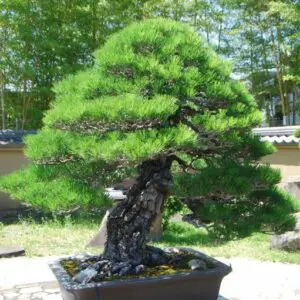
Japanese black pine
Evergreen bonsai trees like pines, spruces and cedars do not completely go dormant in winter. Although growth is nearly absent, they do make energy through photosynthesis using sunlight and water.
Thanks to a heavy wax coating and the fluid inside cells containing substances that resist freezing, their needle-like or scale-like foliage can withstand severe winter conditions. Some evergreen species can even survive in the Arctic as well.
Do evergreen bonsai trees lose leaves?
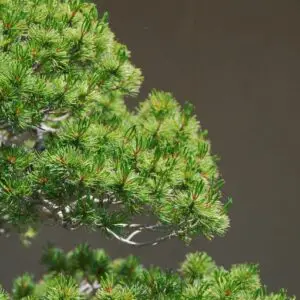
Pine needles
Though evergreens do not shed leaves every year, evergreen needles are not permanent. New needles are produced every spring and summer and survive for some years but eventually fall off because of old age. So it is natural that some of the needles are falling in fall from the inner side of the tree canopy.
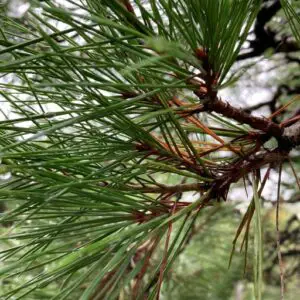
Pine needles turning yellow
Fall needle drop occurs uniformly throughout the tree from top to bottom. If your evergreen bonsai trees are losing needles unevenly, especially from the tip of the branches, you should be concerned. They are certainly not healthy and could be dying.
And if your tree needles turned entirely red or have lost all their needles for some time, they are dead and may not recover. Evergreen bonsai trees never lose all their leaves at once if they are healthy.
Dead or dormant evergreen bonsai? How to tell
Visible test
Here are some of the differences between alive and dead evergreen bonsai trees.
| Alive | Dead | |
| Needles | Green, pointing upward | All red/brown, pointing downward |
| Bark | Without unusual cracks and holes | -Missing bark -Bark peeling away -Multiple cracks on the bark inside of which looks dry -Infestation with insects/fungi |
| Root | White | Dark brown or black |
Alive
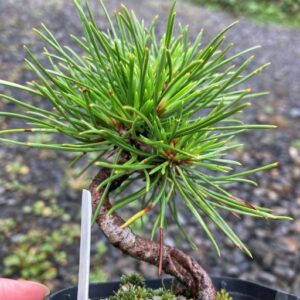
Black pine needles (alive)
Dead
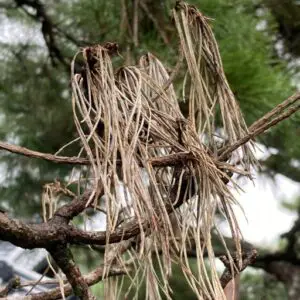
Black pine needles (dead)
If your bonsai trees check all the boxes in “dead” column on the right side, they are probably dead and will not recover. Keep in mind that there are a number of diseases or environmental stresses that can cause needles to look dead even though the tree will recover and be green with new growth in the spring.
Determining whether an evergreen bonsai tree is alive/healthy or dying is much trickier. A tree infested by beetles may be dying but still look green. A healthy-looking tree is not necessarily healthy.
Bending and scratch test
Bending and scratch tests on evergreen bonsai trees may be misleading. Evergreen needles and inner bark look alive long after they are already dead and unrecoverable. It is better to conduct a visible test and wait until the spring to see if new needles start to grow again.


